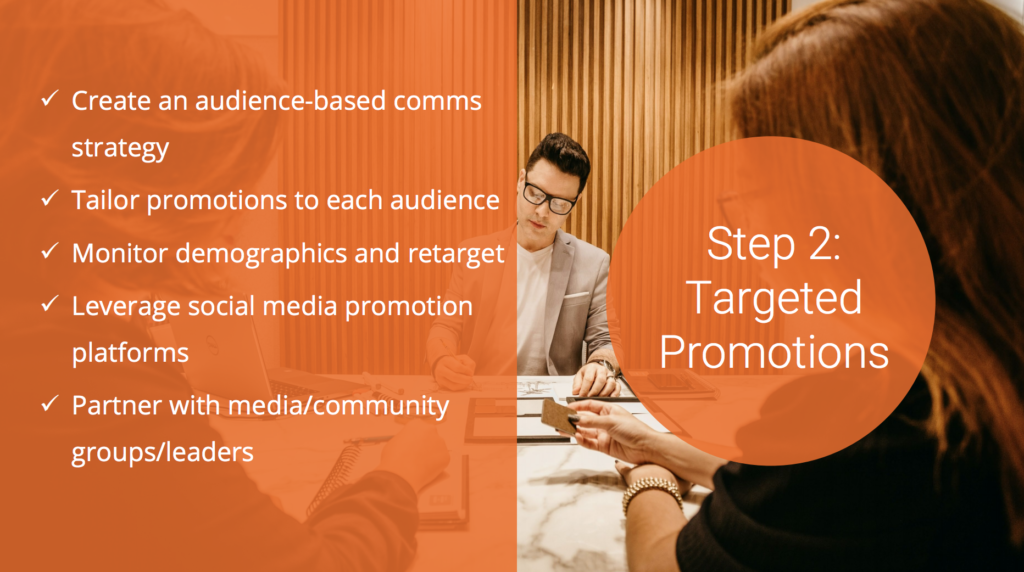Using an Audience-Based Communications Strategy to Increase and Diversify Your Community Engagement

Equitable, transparent, meaningful and inclusive are all common words that are used to characterize great public engagement. In a recent webinar, Dave Biggs, MetroQuest’s Chief Engagement Officer, and Melissa Holguin, Arellano Associates’ Senior Project Manager, explored the proven strategies behind diverse community engagement. They uncovered the ROI of equitable outreach, common barriers leading to poor public participation and a 4-step formula to achieve true diversity and equity when engaging the public!
After exploring the initial element, ‘getting the digital right’, and sharing leading techniques to achieve exceptional results with virtual tools, our expert panel explored targeted promotions: the second and a very important component of the 4-step formula.
You can check out the full details from the webinar in the on-demand recording here! In the meantime, let’s take a deeper dive into one of the promotional techniques that was recommended within the discussion of the second step: using an audience-based communications strategy to increase and diversify your reach in the community.
Diverse Communications Strategies to Reach a Diverse Audience
Once you’ve prepared an engagement opportunity, leveraging compelling, targeted promotions is a leading strategy that agencies and firms of all sizes use. Without promotion, your public engagement will only reach ‘the same ten people’. With an effective communications strategy, you can help elevate exposure of your outreach efforts and encourage more individuals to engage and provide feedback on various plans for the future of their community.
Despite spending great lengths of time and money to craft public engagement promotions, however, several planners still report back that they receive input from the same handful of individuals, resulting in public opinion data that doesn’t truly match the diversity of the area. But why?
It is oftentimes the case that when organizations use a one-off communications approach, they fail to reach a wide and diverse audience. This can be because they fail to initially develop strategies that make sense for and meet the needs of different stakeholder groups, or weren’t able to adapt and adjust communication efforts according to interim results. As Holguin expanded on during the discussion, it’s critical that we take on an integrated approach to reaching our communities. Agencies and firms must understand that a diverse group of individuals exists within the community and a one-size-fits-all promotional effort isn’t going to cut it.
So What is an Audience-Based Communications Strategy?
In essence, developing an effective communications strategy must start from a focus on the audience that the strategy intends to reach. Planners must consider the various audiences and adapt both the message and the media outlet to develop communication strategies that make the most sense for each audience. It’s also important to develop opportunities to sustain communication both before, during and after the public engagement process.
An audience-based communications strategy, as the name suggests, is tailoring your promotional efforts to different groups. Where does your audience spend their time, and how can you tailor your promotions to find them where they already are?
Single parents, students, or young professionals, for example, likely won’t be able to attend scheduled meetings, virtual or otherwise, during business or school hours. But many of them will be on social media, or reachable through email—can you use a targeted Facebook ad that leads them to an online survey that can be taken in just five minutes, while they’re on the bus or waiting in line at the store?
This line of thinking can lead to techniques that help you reach distinct stakeholders, encourage a more diverse group of participants to engage in your outreach efforts and reduce barriers that lead to poor participation within various demographic groups.
Understanding your audiences and crafting promotions that help engage each stakeholder group is a critical part of achieving diverse engagement in planning. In the webinar, Holguin and Biggs unpack several strategies: check out the on-demand recording to learn how you can effectively craft promotions that overcome barriers to participation and achieve true diversity and equity in community engagement here!
How to Achieve True Diversity and Equity in Community Engagement
Learn about the best practices and techniques for going beyond the usual suspects to engage even the most difficult to reach audiences and achieve true diversity and equity in your community engagement.

